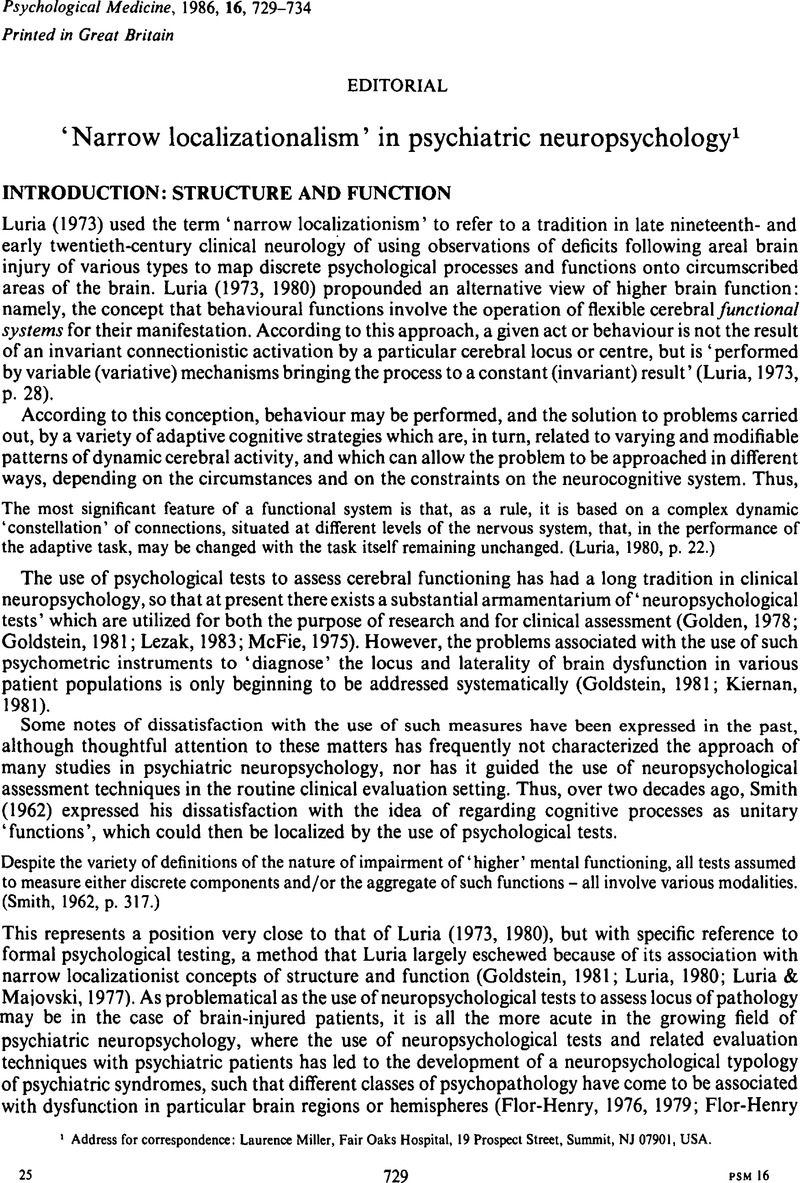Crossref Citations
This article has been cited by the following publications. This list is generated based on data provided by Crossref.
Miller, Laurence
1987.
Neuropsychology of the aggressive psychopath: An integrative review.
Aggressive Behavior,
Vol. 13,
Issue. 3,
p.
119.
Miller, Laurence
1988.
Neuropsychological perspectives on delinquency.
Behavioral Sciences & the Law,
Vol. 6,
Issue. 3,
p.
409.
Miller, Laurence
1988.
Ego Autonomy, Creativity, and Cognitive Style.
Psychiatric Clinics of North America,
Vol. 11,
Issue. 3,
p.
383.
Tataryn, D. J.
Nadel, L.
and
Jacobs, W. J.
1989.
Comprehensive Handbook of Cognitive Therapy.
p.
83.
McClelland, R. J.
1989.
Interaction Between Mental and Physical Illness.
p.
25.
Miller, Laurence
1990.
Neuropsychodynamics of alcoholism and addiction: Personality, psychopathology, and cognitive style.
Journal of Substance Abuse Treatment,
Vol. 7,
Issue. 1,
p.
31.
Miller, Laurence
1991.
Predicting relapse and recovery in alcoholism and addiction: Neuropsychology, personality, and cognitive style.
Journal of Substance Abuse Treatment,
Vol. 8,
Issue. 4,
p.
277.
Miller, Laurence
1991.
Brain and Self: Toward a Neuropsychodynamic Model of Ego Autonomy and Personality.
Journal of the American Academy of Psychoanalysis,
Vol. 19,
Issue. 2,
p.
213.
Miller, Laurence
1992.
Neuropsychology, personality, and substance abuse in the head injury case:.
International Journal of Law and Psychiatry,
Vol. 15,
Issue. 3,
p.
303.
Miller, Laurence
1993.
Freud's Brain: Toward a Unified Neuropsychodynamic Model of Personality and Psychotherapy.
Journal of the American Academy of Psychoanalysis,
Vol. 21,
Issue. 2,
p.
183.
1993.
DSM-IV: "cognitive disorders".
The Journal of Neuropsychiatry and Clinical Neurosciences,
Vol. 5,
Issue. 2,
p.
223.
CHESTERMAN, L.P.
TAYLOR, P.J.
COX, T.
HILL, M.
and
LUMSDEN, J.
1994.
Multiple measures of cerebral state in dangerous mentally disordered inpatients.
Criminal Behaviour and Mental Health,
Vol. 4,
Issue. 3,
p.
228.
Hook, Stephen
Gordon, Evian
Lazzaro, Ilario
Burke, Christine
Anderson, John
Zurynski, Yvonne
Snars, Jeff
and
Meares, Russell
1995.
Regional differentiation of cortical activity in schizophrenia: a complementary approach to conventional analysis of regional cerebral blood flow.
Psychiatry Research: Neuroimaging,
Vol. 61,
Issue. 2,
p.
85.
NESTOR, PAUL G.
SHENTON, MARTHA E.
O'DONNELL, BRIAN
MCCARLEY, ROBERT W.
and
WIBLE, CYNTHIA
1995.
Dr. Nestor and Colleagues Reply.
American Journal of Psychiatry,
Vol. 152,
Issue. 3,
p.
475.
1995.
Association between cognitive deficits and temporal lobe abnormalities.
American Journal of Psychiatry,
Vol. 152,
Issue. 3,
p.
474b.
Miller, Laurence
2000.
Serial Offenders.
Gorissen, Marielle
Sanz, Juan Carlos
and
Schmand, Ben
2005.
Effort and cognition in schizophrenia patients.
Schizophrenia Research,
Vol. 78,
Issue. 2-3,
p.
199.
Strelnikov, Kuzma
2013.
Sensory stimulation induces tensor fields, which specifically transform brain activity.
Neuroscience Letters,
Vol. 554,
Issue. ,
p.
42.
Allott, Kelly
Proffitt, Tina-Marie
McGorry, Patrick D.
Pantelis, Christos
Wood, Stephen J.
Cumner, Marnie
and
Brewer, Warrick J.
2013.
Clinical Neuropsychology Within Adolescent and Young-Adult Psychiatry: Conceptualizing Theory and Practice.
Applied Neuropsychology: Child,
Vol. 2,
Issue. 1,
p.
47.
Miller, Laurence
2014.
Serial killers: II. Development, dynamics, and forensics.
Aggression and Violent Behavior,
Vol. 19,
Issue. 1,
p.
12.



